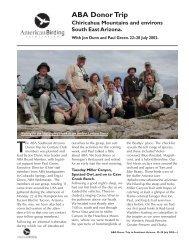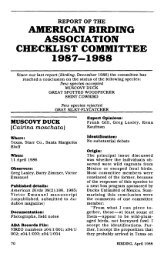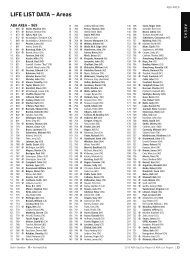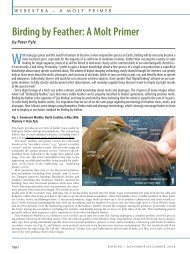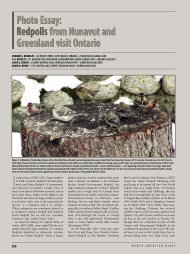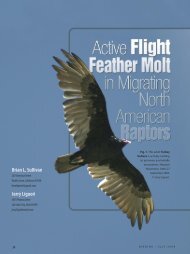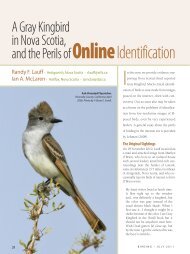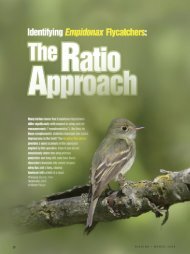as King and Clapper Rails, Nelson’s and Saltmarsh Sharp-tailed Sparrows, and Greattailedand Boat-tailed Grackles (Johnson and Cicero 2004), species pairs withcoastal vs. interior distribution patterns comparable to those <strong>of</strong> Eastern and Western<strong>Willet</strong>s. Playback experiments have demonstrated that Eastern <strong>Willet</strong>s discriminatebetween <strong>the</strong> songs <strong>of</strong> <strong>the</strong> two subspecies, responding to playback <strong>of</strong> Eastern with an83% frequency and to that <strong>of</strong> Western with a 22% frequency (Douglas 1998). However,a similar discrimination was not found when o<strong>the</strong>r vocalizations were played,and Eastern <strong>Willet</strong>s readily recognized and responded to playback <strong>of</strong> all Western<strong>Willet</strong> calls. A thorough study <strong>of</strong> <strong>Willet</strong> DNA is needed to clarify <strong>the</strong> degree <strong>of</strong> geneticseparation between <strong>the</strong>se two taxa.Fig. 6. Juvenile Western <strong>Willet</strong>. JuvenileWesterns usually look pale and buffy-gray overall.Pale marginal spots and dark subterminalmarkings on <strong>the</strong> scapulars, coverts, and tertialsshow relatively low contrast with <strong>the</strong> rest <strong>of</strong> <strong>the</strong>plumage. The flanks are pale and <strong>of</strong>ten appearmostly white under bright lighting conditions.Note <strong>the</strong> long legs; <strong>the</strong> long, straight, evenlytapered,fine-tipped bill; <strong>the</strong> graceful curve to<strong>the</strong> back; and <strong>the</strong> bulge at <strong>the</strong> base <strong>of</strong> <strong>the</strong> neck.North Carolina; late July 1995. © Michael O’Brien.<strong>Identification</strong>Distinguishing between Eastern and Western <strong>Willet</strong>sis mostly a matter <strong>of</strong> size, structure, and overall color.On average, Westerns are larger, paler, longer- andslimmer-billed, longer-legged, and longer-necked thanEasterns. Each <strong>of</strong> <strong>the</strong>se characters is somewhat variable,however, and a small percentage <strong>of</strong> birds look intermediate.Also, populations <strong>of</strong> Eastern <strong>Willet</strong>s on<strong>the</strong> Gulf Coast look subtly larger, paler, and longerbilled,on average, than Atlantic Coast birds. DespiteFig. 7. Breeding Western <strong>Willet</strong>. Note <strong>the</strong> plump, rounded body; <strong>the</strong> slim,fine-tipped bill; <strong>the</strong> tall, rounded crown; <strong>the</strong> long legs; and <strong>the</strong> pale overall coloration.The ground color <strong>of</strong> <strong>the</strong> upperparts is neutral gray, whereas that <strong>of</strong> <strong>the</strong>breast is pale buff. In April, many birds still hold extensive plain gray upperpartsfrom non-breeding plumage. In spring and early summer, <strong>the</strong> bill <strong>of</strong>tenbecomes distinctively dark. Texas; mid-April 2004. © Michael O’Brien.WWW.AMERICANBIRDING.ORG45
W I L L E T SFig. 8. Breeding Eastern <strong>Willet</strong>. Note <strong>the</strong> slim body, <strong>the</strong> relatively heavy bill, <strong>the</strong>shallow forehead angle, and <strong>the</strong> brownish overall coloration. In spring and summer,<strong>the</strong> bill <strong>of</strong>ten becomes distinctively pinkish-based. Dark markings on <strong>the</strong> upperpartsand breast are usually heavier than on Western. Behavioral clues are particularly helpfulalong <strong>the</strong> Gulf and sou<strong>the</strong>rn Atlantic Coasts in spring, when most Easterns are displayingnoisily over salt marsh territories and when most Westerns are foraging quietlyon beaches. Texas; mid-April 2004. © Michael O’Brien.Fig. 9. Breeding Eastern <strong>Willet</strong>. The relatively short, stout, pinkish-based bill; <strong>the</strong>short legs; <strong>the</strong> shallow forehead angle; <strong>the</strong> slim, compact body; and <strong>the</strong> brownishground color to <strong>the</strong> upperparts are distinctive. The heavily barred underparts are probablyoutside <strong>the</strong> range <strong>of</strong> variation <strong>of</strong> Western, although <strong>the</strong> darkest Westerns may benearly as heavily marked. Bill shape is variable in both subspecies. This individual isnormal but on <strong>the</strong> slim end for Eastern. New Jersey; mid-June 2005. © Michael O’Brien.this variation, a combination <strong>of</strong> characters is distinctive inmost individuals. See Figs. 1–12 for details.Molt patterns differ slightly between <strong>the</strong> two subspecies.From an identification standpoint, <strong>the</strong> most useful differenceis <strong>the</strong> geographic region in which <strong>the</strong> prebasic flightfea<strong>the</strong>rmolt takes place. Both subspecies undergo this molton or near <strong>the</strong> wintering grounds, which, for Western <strong>Willet</strong>,includes <strong>the</strong> sou<strong>the</strong>rn coasts <strong>of</strong> North America. Easternsretain full flight fea<strong>the</strong>rs while in North America. Similarly,Easterns undergo only limited prebasic body moltbefore departure in fall, whereas local wintering Westernsundergo <strong>the</strong>ir entire molt here.Vocalizations <strong>of</strong>ten provide a useful means <strong>of</strong> distinguishingbetween Eastern and Western <strong>Willet</strong>s. Differences in <strong>the</strong>primary “pill will willet” song are particularly distinct. Eastern’ssong is an urgent, rapidly-repeated pidl-will-willit.Western’s is a slower, lower-pitched, more clearly annunciatedp’d-weeel-will-wit with <strong>the</strong> second note more drawnoutand <strong>the</strong> last two notes more clearly separated. With a littlepractice, <strong>the</strong> difference is obvious. In both subspecies,songs are given by both sexes, primarily on <strong>the</strong> breedinggrounds but also occasionally during spring migration. Differencesbetween calls are much less distinct that those betweensongs. All calls <strong>of</strong> Western average lower-pitched andmore drawn-out than those <strong>of</strong> Eastern, but much overlapexists and many calls are not readily identifiable to subspecies.The flight call is a loud, strident klaay-drr or klaaydr-dr,typically with a lower, huskier, Marbled Godwit-likequality in Western and a higher, Laughing Gull-like qualityin Eastern. With practice, classic examples <strong>of</strong> <strong>the</strong>se calls aredistinctive but variation precludes <strong>the</strong> identification <strong>of</strong>some. When flushed, both subspecies utter a higher, moreexcited kli-li-li-li, <strong>of</strong>ten with a trilled quality (on average,more distinctly trilled in Western). The breeding alarm callis a sharp, repeated kleep or kalip, lower and more muffledin Western. The year-round alarm is a more drawn-out,screaming klaayii and variations, <strong>of</strong>ten with a distinctlycurlew-like quality, particularly in Western.AcknowledgmentsMuch <strong>of</strong> <strong>the</strong> information in this article has been adaptedfrom The Shorebird Guide, published by Houghton Mifflinin April 2006. I am grateful to my coauthors, RichardCrossley and Kevin Karlson, for sharing <strong>the</strong>ir thoughts on<strong>Willet</strong> identification. Helpful information or discussionswere also provided by Bob Carlough, Steve Howell, TonyLeukering, Paul O’Brien, and Chris Vogel.Literature CitedDouglas, H.D. 1998. Response <strong>of</strong> Eastern <strong>Willet</strong>s (<strong>Catoptrophorus</strong> s. <strong>semipalmatus</strong>) to vocalizations<strong>of</strong> Eastern and Western (C. s. inornatus) <strong>Willet</strong>s. Auk 115:514–518.Johnson N.K., and C. Cicero. 2004. New mitochondrial DNA data affirm <strong>the</strong> importance <strong>of</strong>Pleistocene speciation in North American birds. Evolution 58:1122–1130.Morrison, R.I.G, R.E. Gill, B.A. Harrington, S. Skagen, G.W. Page, C.L. Gratto-Trevor, and S.M.Haig. 2001. Estimates <strong>of</strong> shorebird populations in North America. Canadian WildlifeService Occasional Paper no. 104. Environment Canada, Ottawa.Morrison, R.I.G., and R.K. Ross. 1989. Atlas <strong>of</strong> Nearctic Shorebirds on <strong>the</strong> Coast <strong>of</strong> SouthAmerica, vol. 1. Canadian Wildlife Service Special Publication, Ottawa.Sibley, D.A. 2000. The Sibley Guide to Birds. Alfred A. Knopf, New York.Sick, H. 1993. Birds in Brazil: A Natural History. Princeton University Press, Princeton.46ANSWER: The front bird in Fig. 1 is a Western <strong>Willet</strong>, and <strong>the</strong>rear bird is an Eastern.



